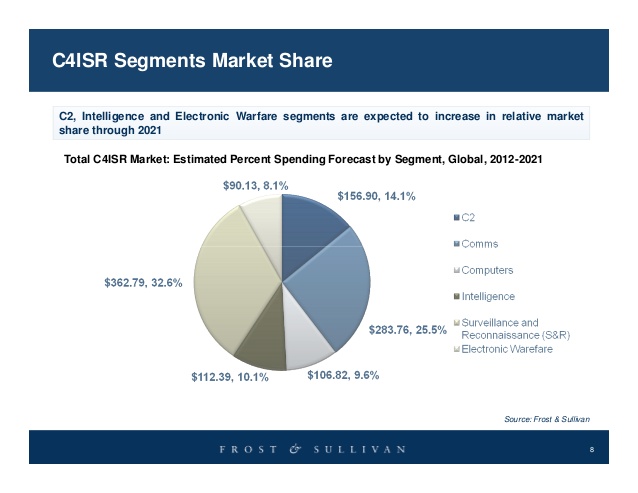

Analysis from Frost & Sullivan, Global C4ISR Market Assessment , finds C4ISR procurement spending stood at $106 billion in 2014 and estimates this to reach $119 billion in 2019. In 2015, C4ISR accounted for nearly 16 percent of the total defense procurement spending. This ratio is expected to remain stable in most countries across the globe with cybersecurity, assured global positioning system (GPS) or navigation, unmanned sea vehicles and missile defense being priorities through 2019.
Click for more information on this research.
“Although the U.S. will dominate global C4ISR spending, its share is likely to reduce from 36 percent in 2015 to 34 percent in 2019 due to a reduction in its force structure and higher procurement rates in Saudi Arabia, Japan and India,” said Frost & Sullivan Aerospace & Defense Industry Principal Brad Curran. “Meanwhile, Africa will witness the highest C4ISR spending compound annual growth rate at 8.4 percent.”
Despite the overall market optimism, the rising trend of equipment-sharing agreements among budget-constrained nations will limit C4ISR spending. Therefore, across geographies, moderately priced mature and proven systems will gain market share. Moreover, maintenance, spares, logistics and training services will become essential components of new sales.
The increased application of commercial off-the-shelf (COTS)-based computing, storage, security, networking and collaboration tools will further boost revenues. To cost-effectively meet military C4ISR operational goals, market participants will have to harness COTS hardware and software as well as the Internet of Things concept.
“The commercial success and reliability of mobile networks have facilitated the military application of remote sensing, big data analysis, robotics, miniaturization, cloud computing services and cybersecurity,” noted Curran. “With IT moving from a hardware setting to a mobile software-defined environment that emphasizes connectivity and the Internet of Things, large commercial IT companies will expand their share of C4ISR spending at the expense of established systems integrators.”
